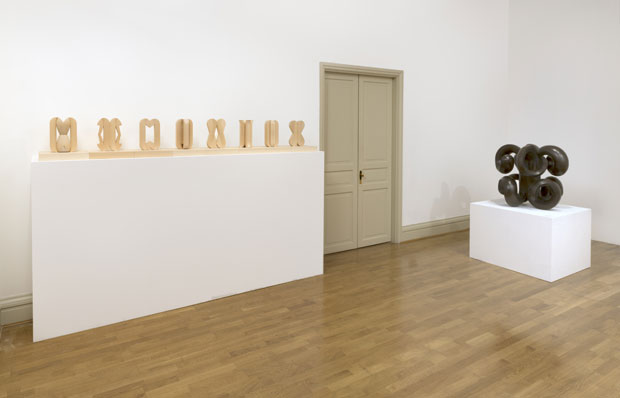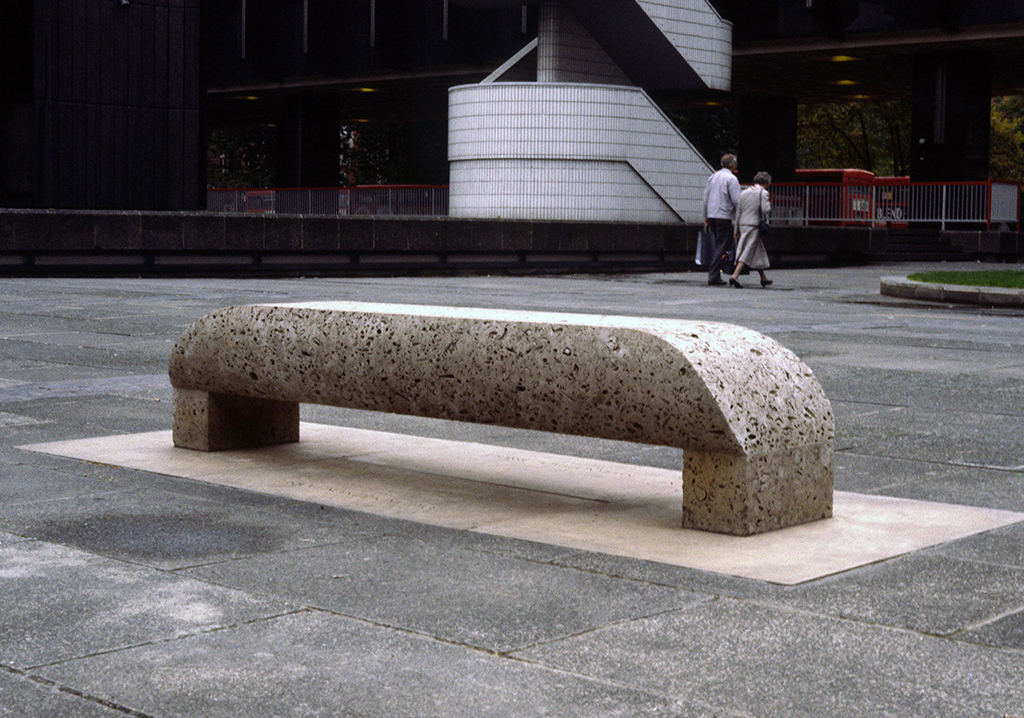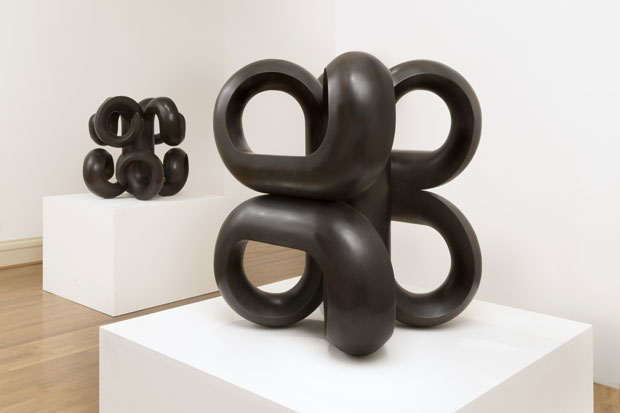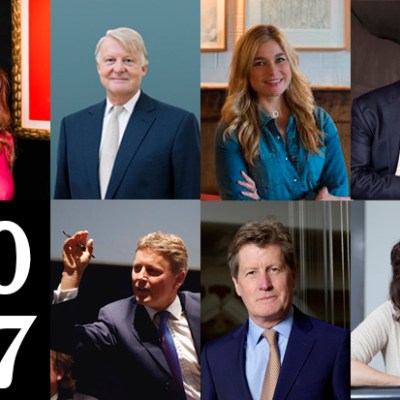‘The process involves finding some kind of core geometry and improvising around it. In this case, it’s about the phenomenon of a mitre, where two curves collide and produce a third shape which is undrawable.’ Paul de Monchaux is introducing his Eight Studies for Male & Female Columns (2014/15), a beguiling set of pale wooden sculptures arranged side by side along a white shelf in Megan Piper’s London gallery. The world ‘undrawable’ lodges in my mind: it seems apt for a group that, while evidently underpinned by formidable logic and precise geometry, remains enigmatic. Each upright form is pristine, self-contained and deceptively simple, its component parts neatly gathered around its central axis – yet each clearly relates to the whole. The artist elaborates: ‘The subsequent seven are all contained in [sculpture] number one…In the back of my mind is a kind of musical variation, where you can build up, you can leave the theme behind.’
Eight Studies for Male & Female Columns (2016), Paul de Monchaux

For decades De Monchaux has been building on a theme, creating compelling abstract sculptures in wood, bronze and stone. Born in Montreal, he claims his first memorable introduction to art was during his youth in New York. ‘I’d just left school, and the place where I worked was very near the Museum of Modern Art. I knew nothing about anything – I was just a dumb kid – but I used to go in there every weekend to look at the free films. Then I began to look around.’ Soon he encountered Brancusi’s stone carved Fish in a room of its own: ‘I was completely overcome.’ He felt the same powerful response to the Archaic Greek and early Egyptian marbles in the British Museum, which he visited frequently while training at the Slade, and in Florence when confronted with its Renaissance architecture. De Monchaux is, without apology, a sculptor in the classical sense. His foray into Abstract Expressionism in the 1950s (he was ‘besotted’ with the American painters who were starting to show in London) did him well, commercially. ‘I made a few pieces trying to improvise around material rather than around the structure, which because of the zeitgeist were well received’, he tells me. ‘But I found after a year or two…there was no real development.’ Soon afterwards he put form back at the core of his work.
For De Monchaux, this was not a rejection of an artistic movement so much as a renewed embrace of a far bigger one. ‘When I had that experience with sculpture [like Brancusi’s], I had a feeling that I really knew the sculptor, that I knew them personally’, he tells me, ‘and coupled with that, a sense that it was all a common enterprise. I think in life one is separate, but in art you’re not.’ Engaging so deeply with art-historical tradition naturally meant mastering its disciplines. De Monchaux coupled life drawing (of the analytic sort) at the Slade with a side job making kerb stones for a quarry in Dorset, so from his earliest days as an artist he was ‘using structures discovered from working on a figure in a way that was not representing one.’ Returning to the Slade in the late 1950s, he embarked on a series of studies of hands. Finding them difficult to model at life size, he scaled them up dramatically: ‘I made a finger about a foot high, to separate out the geometry of the surfaces. Once I’d done that a couple of times I was able to make the life-sized ones because I’d rehearsed the moves.’ Ultimately, it was this careful separation of figurative elements into geometric forms that opened his eyes to the potential of abstraction. From the late ’70s his work has been resolutely non-figurative, ‘but on the other hand’, he reflects, ‘I’m quite sure that having looked at a lot of things over many years, they’re all still feeding in.’
Volute IV (2013), Paul de Monchaux

His Eight Studies for Male & Female Columns don’t look like people, but they do have a sense of humanity to them. To me, they resemble miniature standing stones – a modern homage to some of the earliest examples of the architectural impulse that De Monchaux channels into his work. For this display, the group is paired with two of the sculptor’s most recent Volutes – larger bronze sculptures named after a detail of the curvaceous Ionic capitals from which their forms derive. Classical architecture is well known for the equivalents it draws between buildings and human figures – the slender Ionic order is associated with femininity, the sturdier Doric with masculinity. Structures made by humans, to human proportions, to accommodate people, but using abstract principles: it comes as no surprise that architecture has emerged as such a powerful influence in De Monchaux’s art.
These sculptures, like all of De Monchaux’s mature works, were first realised in plaster. Having settled on a geometric shape to work with, he constructs the component parts and assembles them into compositions through a process of trial, error, and intuition. ‘The permutations are infinite’, he explains, ‘but the seed – the core of it – is really very simple, almost banal…The trick is to find a variation that works as a sculpture. That takes a lot of doing.’ Once he has found something that works, however – and this surely has to do with the architectural aspect of his practice – it tends to have a sense monumentality to it, whatever its scale. ‘I know this goes counter to what many people say – the convention is that it’s a different proposition to have a bigger sculpture and a smaller one, and they should therefore have a different form,’ explains De Monchaux, ‘but I’ve found that if you can get the drawing and the structure, and give it some strength in a maquette, then it’s surprising: you can just keep growing it up.’
Installation view at Megan Piper, London

De Monchaux does, on occasion, work on a larger scale for public commissions. In 1990, for example, he completed a set of four stone benches – now outside Euston station – which are based on a shape similar to that at the core of Eight Studies for Male & Female Columns. ‘You’re recycling things’ all the time, he explains. ‘You try to make something and fail, but the impulse to make it doesn’t go away, and you might succeed in finding the solution to that particular dilemma 10 years later…I’ve been doing this stuff for 60 years now. It constantly seems to be a circle rather than a line.’
Portland Bench (1990), Euston Station, Paul de Monchaux

‘Paul de Monchaux: Ten Columns’ is at Megan Piper gallery (Harris Lindsay), London, until 20 January.



